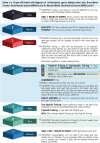Rehabilitation Evidence-Based Decision-Making: The READ Model
- PMID: 36188787
- PMCID: PMC9397823
- DOI: 10.3389/fresc.2021.726410
Rehabilitation Evidence-Based Decision-Making: The READ Model
Abstract
Evidence-based practice is the foundation of rehabilitation for maximizing client outcomes. However, an unacceptably high number of ineffective or outdated interventions are still implemented, leading to sub-optimal outcomes for clients. This paper proposes the Rehabilitation Evidence bAsed Decision-Making (READ) Model, a decision-making algorithm for evidence-based decision-making in rehabilitation settings. The READ Model outlines a step-by-step layered process for healthcare professionals to collaboratively set goals, and to select appropriate interventions. The READ Model acknowledges the important multi-layered contributions of client's preferences and values, family supports available, and external environmental factors such as funding, availability of services and access. Healthcare professionals can apply the READ Model to choose interventions that are evidence-based, with an appropriate mode, dose, and with regular review, in order to achieve client's goals. Two case studies are used to demonstrate application of the READ Model: cerebral palsy and autism spectrum disorder. The READ Model applies the four central principles of evidence-based practice and can be applied across multiple rehabilitation settings.
Keywords: READ model; decision-making; evidence-based; goal-setting; rehabilitation.
Copyright © 2021 Novak, te Velde, Hines, Stanton, Mc Namara, Paton, Finch-Edmondson and Morgan.
Conflict of interest statement
The authors declare that the research was conducted in the absence of any commercial or financial relationships that could be construed as a potential conflict of interest.
Figures
References
-
- Barrable B, Thorogood N, Noonan V, Tomkinson J, Joshi P, Stephenson K, et al. . Model for bridging the translational “valleys of death” in spinal cord injury research. J Healthc Leadersh. (2014) 6:15–27. 10.2147/JHL.S58649 - DOI
Publication types
LinkOut - more resources
Full Text Sources



